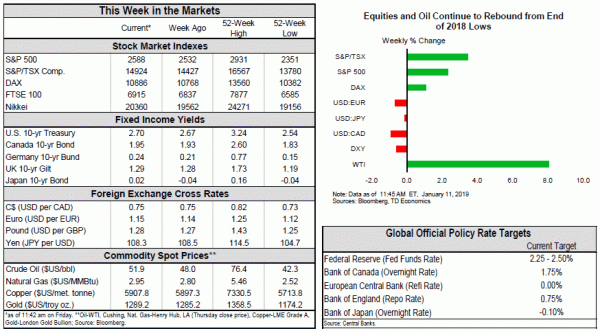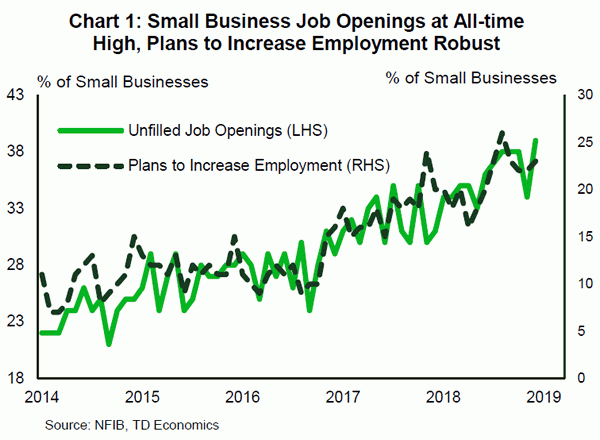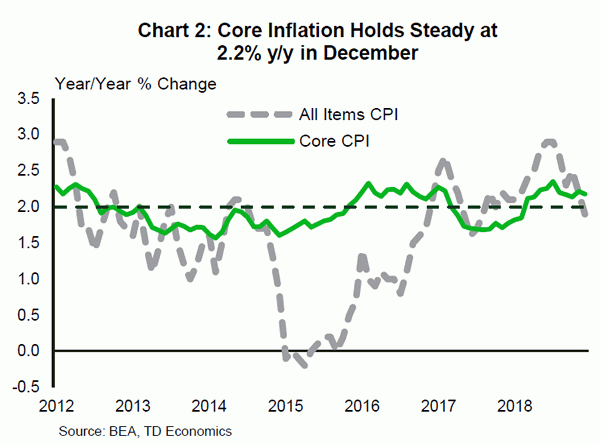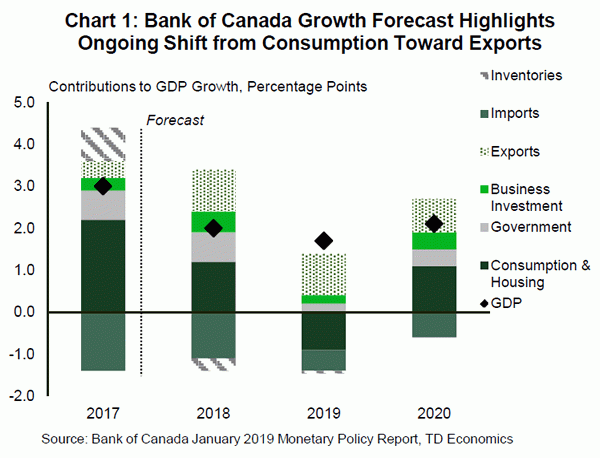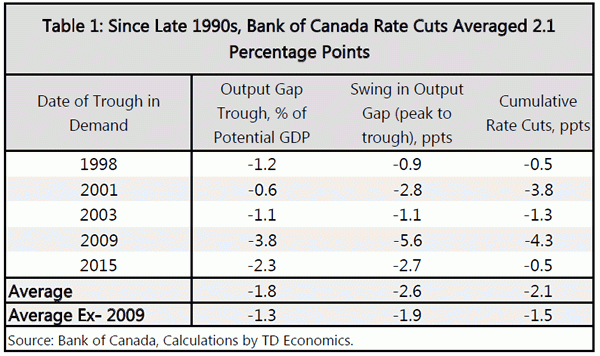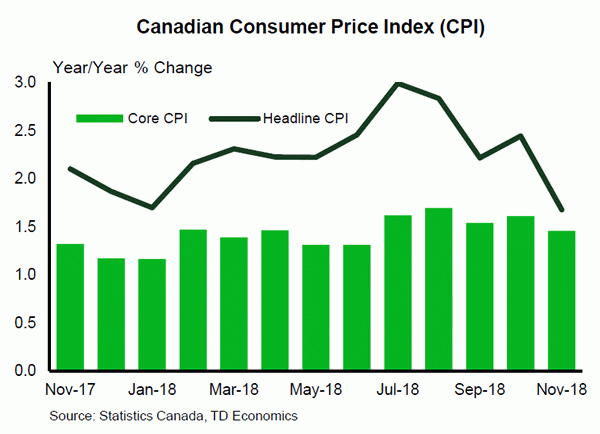U.S. Highlights
- U.S. equity markets built on last Friday’s gains, firming up for the second consecutive week. Seemingly-fruitful trade negotiations between the U.S. and China offered notable support.
- With respect to data, both the ISM non-manufacturing index and small business confidence have eased from recent highs, but remain in healthy territory. Inflation data came in as expected, with core CPI holding steady at 2.2% y/y.
- The government shutdown, which is on track to become the longest in U.S. history, may test the Fed’s wait and see approach to monetary policy, given data distortions and delays. If it ends soon, we expect its impact to be quite modest. But each passing week has the potential to amplify the impact.
Canadian Highlights
- As widely anticipated, the Bank of Canada held its policy rate at 1.75% this week. It also signaled little desire to raise rates in the near term.
- Energy sector woes are expected to drag on Canadian economic activity to the tune of half a point through 2020. As a result, 2019 growth was downgraded by 0.4 ppts to 1.7% relative to the Bank’s October outlook.
- With the Bank of Canada communicating less urgency to raise rates in the near-term, we now expect the next rate hike to occur in July.
U.S. – Of Mending Bridges and Building Fences
U.S. equity markets built on last Friday’s gains, firming up their comeback in the second week of 2019. The strong December jobs report continued to buoy market sentiment, while seemingly-fruitful trade negotiations between the U.S. and China offered additional support. Discussions in Beijing lasted an extra day, with indications that progress was made on a few items of interest, such as the further solidification of Chinese commitments to purchase U.S. goods. China’s Commerce Ministry suggested that progress was made on more contentious issues as well, such as forced technology transfers and the protection of IP rights. The finding of common ground is a very encouraging development. But, with plenty of work still to be done and details to be hashed out, we’re not out of the woods yet.
On the domestic data front, the numbers this week did little to rock the boat. After a hot three-month streak, the ISM non-manufacturing index descended below the 60-point threshold in December. But, at a reading of nearly 58, the index still points to a healthy pace of expansion for the lion’s share of the economy. Similarly, small business confidence eased off at the end of 2018, but remained quite upbeat relative to history. Employment indicators from the small business survey also reaffirmed the strength the U.S. labor market (Chart 1).
What truly dominated headlines this week were negotiations related to border security that hold the key to ending the partial government shutdown. Talks this week have so far failed to yield positive results. The current shutdown has already matched the longest 21-day closure of 1995-96 and appears likely to extend further.
The shutdown only adds to the cloud of uncertainty facing the Fed. Indeed, the FOMC minutes confirmed that after hiking in December, there was less certainty going forward given recent volatility in financial markets and concerns about global growth. With price pressures easing off in recent months, the Fed is in no rush to hike rates. This narrative is corroborated by today’s CPI data where core inflation held steady at 2.2% y/y (Chart 2). But, this wait and see approach will be challenged by the government shutdown, which will distort the data and delay its release.
Ultimately, the length of the shutdown will determine the overall impact. If it ends over the weekend, we expect the impact to be fairly modest, with the closure shaving off about 0.1 p.p. from first quarter economic growth. But the impact could prove to be non-linear, meaning that the economic costs rise with time. With respect to data, if the shutdown extends to next week the jobless rate could tick up by 0.2 p.p. as some 380k furloughed workers are counted as unemployed, though January payrolls should be spared the distortion. Delays will add to the fog. So far, only second tier indicators such as factory orders and new home sales have been affected. Among primary releases, the retail sales report is next in line to be taken off of the queue, with more releases impacted and uncertainty mounting the longer the shutdown continues.
Canada – Bank of Canada’s Odyssey Continues
This week the Bank of Canada held its policy rate at 1.75% while also signaling little desire to hike again in the near-term. The pause was largely anticipated given recent weakness in Canada’s energy sector, global financial and commodity markets, and concerns about global growth.
The reasons for delaying further increases are twofold. First off, energy price weakness and mandated production cuts are likely to shave about half a point off the level of Canadian GDP through 2020. This is roughly a quarter of the estimated drag that the 2014-2016 energy shock exerted on economic growth. The less pronounced impact is due to a smaller energy price decline (25% vs 70% in 2014-16), greater industry efficiencies, and lower representation of the energy sector in total investment. As a result, the Bank’s 2019 growth forecast for Canada was revised lower by 0.4ppts to 1.7%. This change includes limited spillovers to other sectors of the Canadian economy, as the negative income shocks from the decline in prices, output, and investment take their toll.
Secondly, Governor Poloz cited that U.S.-led trade tensions are having a negative effect on the global economy. Moreover, global financial and commodity market volatility, and a potential escalation in trade tensions could worsen the global picture. As such, this elevated level of trade uncertainty is expected to continue to weigh on Canadian business investment and exports.
Still, despite the temporary energy sector challenges, trade tensions, financial market volatility, and anticipated slowdown in foreign demand, the Bank remains generally upbeat about the medium-term outlook for the Canadian economy. Its forecasts continue to emphasize the economy’s shifting dependence away from household spending and housing toward exports and non-energy sector business investment (Chart 1).
All told, these and other negative developments, including downward historical revisions to economic growth, suggest that Canada’s economy could be operating with more slack than previously estimated. Given inflation is at target and unlikely to march substantially higher in the year ahead, the Bank no longer has the same sense of urgency to raise rates and get back home to ‘neutral’ (estimated between 2.5-3.5%). Moreover, patience allows for time to assess how the economy evolves as mandatory production cuts are reduced in scope. As such, we expect the next rate hike to now come in July.
The Bank’s odyssey is likely coming close to a conclusion. Given uncertainty about estimates of trend output and the neutral rate, interest rates may not have to rise much higher. Even at 2%, and assuming an estimated -50bps lower bound on the policy rate, the Bank may have just enough ammunition to combat the next downturn (Table 1). Of course, this assumes that it avoids a U.S. style household deleveraging, a turn of events that could require much greater stimulus than interest cuts alone could deliver.
Canada: Upcoming Key Economic Releases
Canadian Consumer Price Index – December
- Release Date: January 18, 2019
- Previous: -0.4% m/m, 1.7% y/y
- TD Forecast: -0.4% m/m, 1.7% y/y
- Consensus: -0.3% m/m, 1.7% y/y
Despite the persistent drop in oil prices through December, we expect CPI to stabilize at 1.7% y/y helped by base effects and higher core inflation. We expect to see gasoline prices down roughly 7% m/m following a 9% drop in November. Outside of energy, past CAD depreciation (-3% since October), which propped up import prices, underpin food and core (ex food and energy) prices this month, with the latter expected to firm to 1.9% y/y from 1.7%. Airfares, however, are again a source of uncertainty as recent methodology changes make monthly figures over the next year more uncertain. Overall we view risks as skewed slightly to the downside for this report. Our forecast, if realized, would also still leave Q4 CPI tracking at 1.9% y/y, below the BoC’s forecast of 2.0% from the January MPR. Looking ahead, the recent drop in oil prices and our revised commodity price outlook suggests headline inflation will remain below target for most of 2019, before rebounding back to 2% next December.




